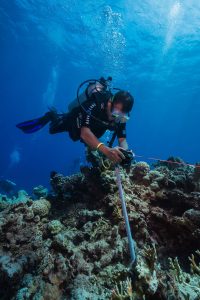Reef monitoring app helps protect marine biodiversity
How can you tell if coral reefs are doing okay? One way is to observe them. What types of fish and other organisms appear or disappear? What is the total level of biomass and how does it compare to other areas in the ocean? Watching those trends over time can provide information on the factors that might increase reefs’ resistance to climate events and support their recovery in the future. For example, fish biomass can nearly double in response to food availability, and over time, can clean the reef to facilitate recovery.
Leaders of the Micronesia region in the Pacific, who set themselves a bold challenge to effectively manage at least 50% of their marine resources by 2030, embarked on the mission to set up a widespread Reef Monitoring Network to keep a close eye on the health of their local coral reefs. To do that effectively and see if their conservation efforts are working, they needed two things—a standardized system for data collection and an analytical tool, which would provide quick and easy access to data.
That’s how Micronesia Reef Monitoring App was created. It is a unified, safe, and accessible platform to hold the growing regional datasets, gathered by hundreds of people within the Micronesia Reef Monitoring Network. It provides impactful data visualization, giving conservationists and decision-makers quick and easy access to valuable insight hidden in the vastness of information. From the number and types of fish which inhabit certain sites to changes over time and comparisons with other locations. It displays complex sets of data in an easy-to-understand way, paving the way for better climate action and regulation.
Dr. Peter Houk, from the University of Guam Marine Lab, says the Micronesia Reef Monitoring App has created effective science-to-management feedback loops that are already benefiting corals, fisheries, and communities that rely on those resources.
“For example, it showed us an unexpected decline in sea cucumber abundance in Pohnpei Islands, Federated States of Micronesia. This decline was noted in marine protected areas as well as reefs open for fishing,” Houk said. “It was revealed that illegal harvesting was occurring, and the information was provided to local stakeholders and local media. The results were a recent court case where the youth of Pohnpei won the right to protect the sustainability of their resources and stop illegal harvesting. The new app allows us to view new data immediately after being collected while providing safe and reliable data storage for many stakeholders. This is having a positive impact on the resources and the communities that benefit from healthy and sustainable resources use.”
About Appsilon
Appsilon provides innovative data analytics and machine learning solutions for Fortune 500 companies, NGOs, and non-profit organizations. The company’s core purpose is to advance technology to preserve and improve life on Earth. Committed to positively impacting the world, Appsilon’s team routinely contributes their time and skills to Data for Good projects, offering many of its services at significantly reduced rates or pro-bono.
About Micronesia Reef Monitoring Network
Micronesia Reef Monitoring Network was created as part of the Micronesia Challenge, an initiative set up in 2006 by the leaders of the Micronesia region, who made a bold commitment to conserving at least 30 percent of near-shore marine resources and 20 percent of terrestrial resources by 2020. It is a network of people, governments, islands, seas and forests that includes the four island states of the Federated State of Micronesia, Yap, Chuuk, Pohnpei, and Kosrae; The Republic of the Marshall Islands; The Republic of Palau; and the two U.S.-affiliated islands: Guam and the Commonwealth of the Northern Mariana Islands. Since its inception, the Micronesia Challenge has successfully protected land and sea for people and nature, inspiring other nations to take similar action. Leaders of Micronesia have now committed to the Micronesia Challenge 2030 goal for effective management that will increase from 30% to 50% of marine resources and from 20% to 30% of terrestrial resources across Micronesia. (PR)

























